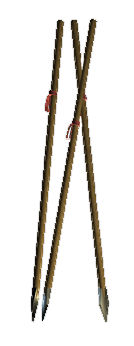Object Descriptions Tower House Storage Room and Armory
Long darts
These long darts, or throwing spears with finger-loops, resemble those used by the native Irish and are modeled on the weapon held by English Captain Tom Lee in the portrait (c. 1590s) by Marcus Gheeraerts (Tate Gallery, London). In John Derricke’s opening plates to The Image of Irelande (1581), the Irish are pictured holding spears or long darts. They were often used in pairs by light foot-soldiers known as “kern” (Irish caithern).
Literary Connections
In A View of the Present State of Ireland, Spenser’s spokesman Irenius describes the weapon as deriving from the ancient Gauls, a Celtic tribe on the Continent who used them against the ancient Romans (View 62).
In The Faerie Queene, the angry, fiery villain Atin carries “in his hand two dartes exceeding flit,/ And deadly sharp he held, whose heads were dight/ In poyson and in blood, of malice and despight” (FQ II.iv.38.7-9). He attacks Guyon, the hero of Temperance, with one of them:

With that one of his thrillant darts he threw,
Headed with yre and vengeable despight;
The quiuering steele his aymed end wel knew,
And to his brest it selfe intended right:
But he [i.e., Guyon] was wary, and ere it empight
In the meant marke, aduaunst his shield atweene,
On which it seizing, no way enter might,
But backe rebownding, left the forckhead keene;
Eftsoones he fled away, and might no where be seene. (FQ II.iv.46)
Atin carries two darts and (unlike those pictured here) each has a forked head: like a snake’s forked tongue, they are emblematic of his treachery and divisiveness, his “malice and despight.” Atin may also allude to the Irish. Not only do his darts point in this direction, but so does his name: tine means “fire“ in modern Irish (Steinberg).
Bibliography:
Joan Heiges Blythe, “Ate.” The Spenser Encyclopedia. Ed. A. C. Hamilton (Toronto: U of Toronto P, 1990), 76.
John Derricke, The Image of Irelande (1581). Ed. D. B. Quinn (Belfast: Blackstaff, 1985).
Clarence Steinberg, “Atin, Pyrochles, and Cymochles: on Irish emblems in the Faerie Queene.” Neuphilologische Mitteilungen 72 (1971), 749-61.